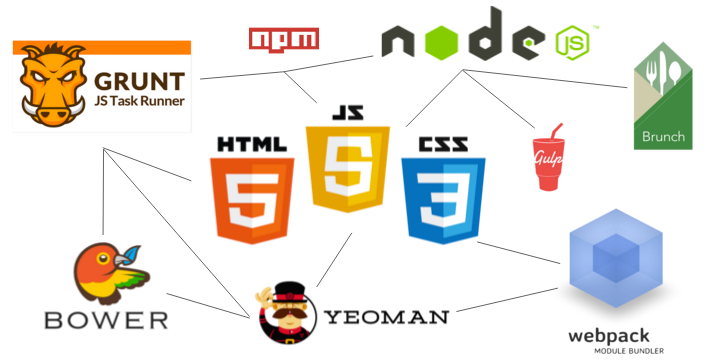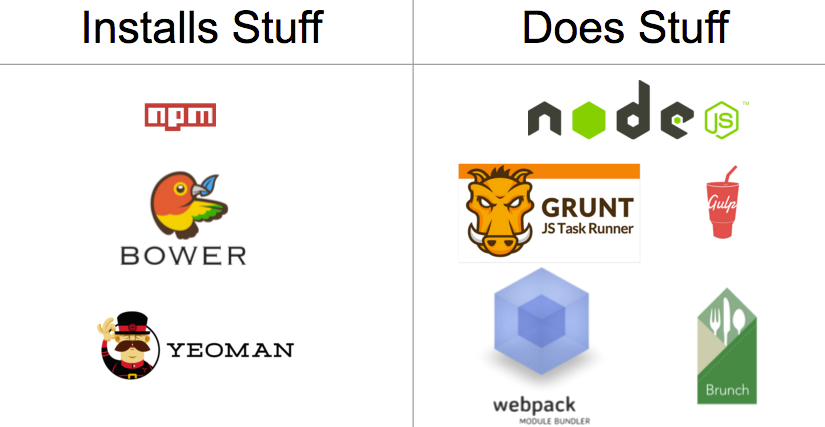I finally made sense of front end build tools. You can, too.
来源于:https://medium.freecodecamp.com/making-sense-of-front-end-build-tools-3a1b3a87043b#.nvnd2vsd8

Front end build tools can be confusing even to experienced developers like me. The solution is to understand how they work — and work together — on a conceptual level.
This article presents my opinionated approach to making sense of front end build tools. Instead of diving into code, I’ll walk you through my mental model of how these tools work and what they accomplish.
Don’t be intimidated by the state of the art
Node, NPM, Grunt, Gulp, Bower, Webpack, Browserify, Yeoman, Brunch… there are so many front-end build tools out there that it can seem impossible to keep up.
The key is not being intimidating. All of these projects are designed to make your life easier.
To understand the what, why, and how of these tools, you just need to grasp a few concepts.
Concept #1 — The core dichotomy of build tools is “installing vs. doing”
Build tools do two things:
- Install things
- Do things
The first question to ask yourself when confronting a new build tool is: “Is this tool intended to install things for me, or do things for me?”
“Installing” tools like npm, Bower, and Yeoman can install pretty much anything. They can install front-end libraries like Angular.js or React.js. They can install servers for your dev environment. They can install testing libraries. They even help you install other front end build tools.
In short, they install most any code-related things you can think of.
The “doing” tools like Grunt, Webpack, Require.js, Brunch, and Gulp are much more complicated. The goal of the “doing” tools is to automate all the menial and error prone tasks in web development. The things they do are sometimes called “tasks.”
To do these “tasks” they often use their own ecosystem of packages and plugins. Each tool writes tasks in different ways. These tools also don’t all do the same thing. Some “doing” tools try to handle any task you throw at it (Grunt, Gulp, etc). Others focus on one thing, such as handling Javascript dependencies (Browserify, Require.js, etc).
Sometimes you end up using several of these tools in the same project.
Here’s a short list of “tasks” I’ve automated with these “doing” tools:
- Replacing a string of text in a file
- Creating folders and moving files into those folders
- Running my unit tests with a single command
- Refreshing my browser when I save a file
- Combining all my JavaScript files into one, and all my CSS files into one
- Minifying my concatenated JavaScript and CSS files
- Modifying the placement of <script> tags on an html page
Once you understand that tools install stuff or do stuff, categorizing them becomes much easier:

Build tools sorted by whether they primarily install things or do things
Concept #2 — The grandparent of all build tools is Node and npm
Node and npm install and run all these build tools, so there is always a trace of them in your project. Because of this, many developers try to use these two tools as much as possible before they resort to installing an additional tool.
Node and NPM fall into our “build” and “do” dichotomy. Node is the “do” tool, and npm is the “install” tool.
npm can install libraries like Angular.js or React.js. It can also install a server to run your app locally for development. It can even install tools to do things like minify your code.
Node, on the other hand, “does” things for you, like run JavaScript files, servers, and so much more.
If you need a place to start learning, start with Node+npm, and stay there for a while. When your project gets large enough, you’ll reach the limits of what Node and npm can automate for you. At that point you can organically incorporate another build tool.
Concept #3 — A build is just a production ready version of your app
Developers often break JavaScript and CSS out into separate files. Separate files let you focus on writing more modular chunks of code that do one single thing. Files that do one thing decrease your cognitive load. (If you think separate files are more confusing than one large file, try working in a 5000 line file, and you will quickly change your mind
I finally made sense of front end build tools. You can, too.的更多相关文章
- VS报错:The build tools for v140 (Platform Toolset = 'v140') cannot be found
VS低版本打开高版本常会出现的错: The build tools for v140 (Platform Toolset = 'v140') cannot be found. To build usi ...
- 开发错误记录3:问题 Error:failed to find Build Tools revision 23.0.2
今天导入swiperefreshlayoutdemo 问题 Error:failed to find Build Tools revision 23.0.2 修改build.gradle 里面设置,其 ...
- SDK Build Tools revision (19.0.3) is too low for project Min
SDK Build Tools revision (19.0.3) is too low for project Min(转) 如果你正在使用Android Studio工具进行开发,且将 ...
- 关于SVN下载代码和Android Studio里面导入别人代码build tools不一致问题总结
项目build tools的sdk我没有 网络问题没法下载. 解决问题 方法 1.下载对应的SDK.需要VPN,或者FQ 2.将bulid.gradle的内容用下面的内容替换 // Top-level ...
- Gradle sync failed: failed to find Build Tools revision 21.1.2
从github上下载了一个开源项目到Android Studio 出现以下问题: 下午2:56:05 Gradle sync started下午3:00:11 Gradle sync failed: ...
- using 1.7 requires using android build tools version 19 or later
这意思大概是adt用了1.7,abt(android build tools)就要用19或更高,可是abt在哪设置呢,原来是在sdk manager中 之前我已安装的最高的abt是17,然后~~~,F ...
- Error:The SDK Build Tools revision (19.0.3) is too low for project ':app'. Minimum required is 19.1.
今天更新了一下AndroidStudio, 结果编译程序时报错, 错误如下: Error:The SDK Build Tools revision (19.0.3) is too low for pr ...
- building 'twisted.test.raiser' extension error: Microsoft Visual C++ 14.0 is required. Get it with "Microsoft Visual C++ Build Tools": http://landinghub.visualstudio.com/visual-cpp-build-tools
Error msg: building 'twisted.test.raiser' extension error: Microsoft Visual C++ 14.0 is required. Ge ...
- Android sdk platform,sdk tools,sdk Build tools,sdk platform tools 的关系
1. sdk platform 简单理解为系统版本 最新级别: 28:Android 9 27:Android 8.1 26:Android 8.0 25:Android 7.1 24:Android ...
随机推荐
- SharePoint 2013 图文开发系列之可视化WebPart
有了WebPart开发的基础,再进行可视化WebPart开发,就容易多了.创建和开发过程,两者非常相似,下面,我们简单介绍下可视化WebPart的开发. 1.添加新项目,选择SharePoint 20 ...
- SharePoint项目实践中如何实现非打破继承看上去很美的权限控制
首先对于比较机密的数据,打破继承还是必须要的. 但是对于一些普通申请单据,虽然客户也希望用户不要看到其他人的申请单据,但是我还是不推荐打破继承,应为打破继承一方面会造成网站的权限管理特别的凌乱,另一方 ...
- [转]利用JitPack发布自己项目让别人可以在dependencies中compile的简单方法
JitPack的地址为:https://jitpack.io/ 发布 登陆 jitpack 在编辑框中输入github的网址,完成后点击LookUp 使用 点击 Get it. 之后网页就会自动导航到 ...
- 浅谈RecyclerView(完美替代ListView,GridView)
Android RecyclerView 是Android5.0推出来的,导入support-v7包即可使用. 个人体验来说,RecyclerView绝对是一款功能强大的控件. 首先总结下Recycl ...
- python之import子目录文件
问题: 在pre_tab.py文件下: print("AA") from test.te import login1 login1() from test.te import ...
- JQuery,C#,sqlServer 实现无极限多级树形控件
最近好忙,好长时间没有更新博客了.......... 先看效果图: 此控件利用了 JQuery 插件: treeview google直接搜索就可以找到,这里就不提供链接了. 下载下来的压缩包包括了源 ...
- 【转】Hadoop FS Shell命令
FS Shell 调用文件系统(FS)Shell命令应使用 bin/hadoop fs <args> 的形式. 所有的的FS shell命令使用URI路径作为参数.URI格式是scheme ...
- 不同版本SQL SERVER备份还原时造成索引被禁用
以下测试例子以SQL 2008备份,在SQL2014还原,造成索引被禁用. --备份环境(SQL Server 2008 R2) /* MicrosoftSQL Server 2008 R2 (RTM ...
- MySQL行锁深入研究
原文:http://blog.csdn.net/minipeach/article/details/5325161/ 做项目时由于业务逻辑的需要,必须对数据表的一行或多行加入行锁,举个最简单的例子,图 ...
- php时间
date_default_timezone_set('PRC'); //默认时区 //当前的时间增加5天 $date1 = "2014-11-11"; echo date('Y-m ...
